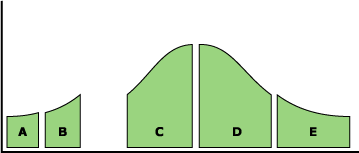While I was writing this piece, I was thinking about how to find the threshold at which an idea is too confusing for what should be its target audience. I don't have a good answer to that, but I started thinking about the art market as an idea market.
This made me think that there may be a similar chasm in art, which would imply that there's a similar chasm in all idea adoption. Look at the Moore curve again:

If the slices are relabled as follows, it still makes some sense:
A: avant-garde
B: experimental
C: mainstream
D: clich�
E: kitsch
Now, of course, the size of the slices doesn't represent the market size--there's a lot of kitsch out there--but maybe it represents the visibility of the style or the recognition of the style as "interesting." Anyway, it seems to make sense, though I haven't quite figured out how.




I agree, it does have a gut level accuracy. One possible explanation for the pattern in the music business is that it is designed to to bring new things across the gap and then maximize the peak of the curve. I don't know enough about post-modern art in other contexts to know how it applies there, but it seems you can see this in the popularity of Michael Graves' bulbous modernism being so popular at Target.
It appears to me to be a function of people encountering the new thing in a context that allows them to see how it relates to their own lives. I don't think that's different from what Mike said, more a restatement.
I agree that it's an idealized vision and often doesn't match reality, but I think that the cycle has a gut-level accuracy, even if it doesn't flow at the same rate every time.
In re: postmodernism: what you're saying is that it's more prevalent in art than in other forms of idea consumption and because it's consciously based on reference, it can jump from one stage of my model to another. Is that correct?
If so, I don't think that's true. I think that the cycle can be occasionally quite compressed in places, but I think it still follows the same pattern. In fact, to bring back Moore's original idea: some ideas/styles never cross the chasm, and others jump very quickly (the "sound" of granular synthesis went from being an avant-garde idea for years to the warble in Cher's voice to the warble in every dance-pop song in about 6 months).
This translation leaves out the enormous appeal of post-modernism in our art consumption...something that is not shared by our product (or even idea) consumption, I'll suggest.
The garage-rock revolution (or whatever the media and industry wonks have labeled it as) was an attempt to subvert or accelerate or alter the cycle from underground to mainstream. I don't think anyone knows how it happened except some journalists at the NYT starting writing about the White Stripes before they "should" have (and then the New Yorker followed suit, if I remember properly).
The changing standards that make something mainstream or experimental can be very marketplace driven, especially in music. The Beatles aesthetic was horrifying for some, it's seemed quaint for a VERY long time. The Ramones stepped way outside the mainstream, they seemed cute by the time they broke up.
And since Spike Jonze (and others before obviously), the way that acts recast themselves as homages/parodies/references to earlier epochs lets them play the post-modern slim edge very nicely....